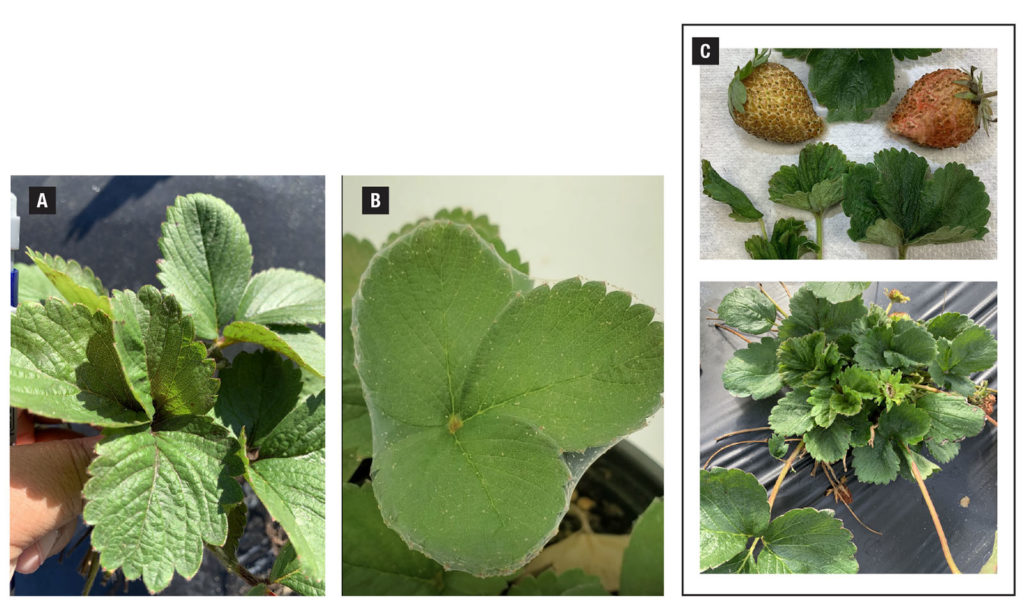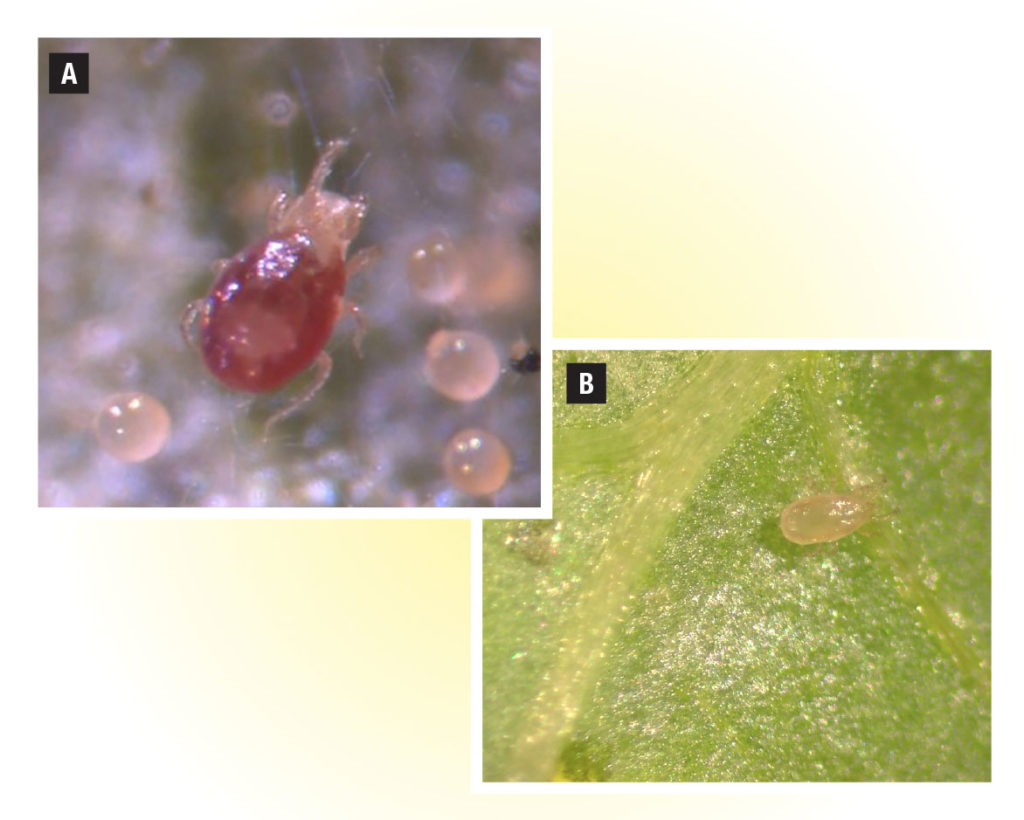
By Sriyanka Lahiri
Thrips
Crop rescue through a well-planned pesticide rotation program currently remains the most effective method of pest management in conventionally grown strawberries. However, close monitoring for pests should be conducted as the first line of defense, especially since most strawberry pests are not visible through unaided vision.
Flower thrips immatures and adults can feed on the fruit with their piercing-sucking mouthparts and cause injury. However, in Florida, strawberries are infested with chilli thrips (Scirtothrips dorsalis) even earlier, since this thrips pest has a taste for the strawberry crown and young fully expanded trifoliates (Figure 1A). Thrips are particularly damaging as they feed on fruits, causing bronzing and cracking of the fruit.

For thrips management, a rotation program using conventional insecticides based on the active ingredients spinetoram (Radiant SC), cyantraniliprole (Exirel), flupyradifurone (Sivanto Prime) and acetamiprid (Assail) can be effective. Of these, spinetoram is most effective as it controls both the adult and larval chilli thrips populations. Most of the other products are effective in managing the adults only.
However, for thrips larvae too, predatory mites such as Amblyseius swirskii and Neoseiulus cucumeris (Figure 2B) are commercially available and effective.
None of these pesticide products should be applied more than two times in a season.
Spider Mites
Twospotted spider mites (Tetranychus urticae) occasionally infest certain fields, especially under warm and dry conditions when plants are stressed. T. urticae may travel with the strawberry transplants from nurseries or migrate from surrounding vegetation. Affected plants show stippling injury at feeding sites on mid-sized trifoliates. Extreme spider mite infestation is clearly visible because foliage is covered with webbing (Figure 1B).
Strawberry transplants from nurseries may occasionally be infested with cyclamen mite (Phytonemus pallidus, Figure 1C). Cyclamen mites have piercing-sucking mouthparts, just like spider mites and thrips. These mites feed on young, folded leaves close to the crown as well as underneath flower and fruit calyces. Affected plants have stunted and deformed young trifoliates causing a symptom called compact-leaf mass (Figure 1C). This occurs because older trifoliates remain normal sized, but younger infested trifoliates remain stunted and appear bunched up at the center of the plant when finally beginning to expand. Such plants do not produce any flowers, or they abort flowers under heavy cyclamen mite infestation, leading to loss of fruit yield.
Clean nursery plants devoid of mites are the best option to avoid undetectable mite infestations. Removal of the infested plants early in the season could also avoid severe mite issues later. Mites are very difficult to get rid of once eggs have been laid.
Abamectin (Agri-Mek) is a locally systemic active ingredient and can be used to control spider mites and suppress cyclamen mites with adequate use of water to assure proper coverage. Abamectin can be rotated with bifenazate (Acramite), fenpyroximate (Portal) or cyflumetofen (Nealta).
However, biological control of spider mites using releases of the predatory mite Phytoseiulus persimilis (Figure 2A) is currently proving to be the most feasible and sustainable option. Care should be taken to not spray the field with broad-spectrum pesticides immediately after the release of predatory mites.
Armyworms and Aphids
Armyworms and aphids may occur as minor pests. Armyworms are effectively managed by early-season application of the biorational insecticide formulations of Bacillus thuringiensis, subsp. kurstaki. Aphid outbreaks are localized and best managed by allowing natural enemies such as predators (lady beetles, lacewings and hoverfly) and parasitoids to suppress their populations.
Plants with signs of pest infestation should be flagged in the field to monitor for spread and to make a pest management decision.
Pesticides registered for various strawberry pests are listed in Chapter 16 of the University of Florida Institute of Food and Agricultural Sciences (UF/IFAS) Vegetable Production Handbook of Florida 2020-2021 (edis.ifas.ufl.edu/pdf%5CCV%5CCV29200.pdf). It is important to select pesticides that are least harmful to beneficial arthropods, rotate modes of action and follow the label.
Sriyanka Lahiri is an assistant professor at the UF/IFAS Gulf Coast Research and Education Center in Wimauma.









